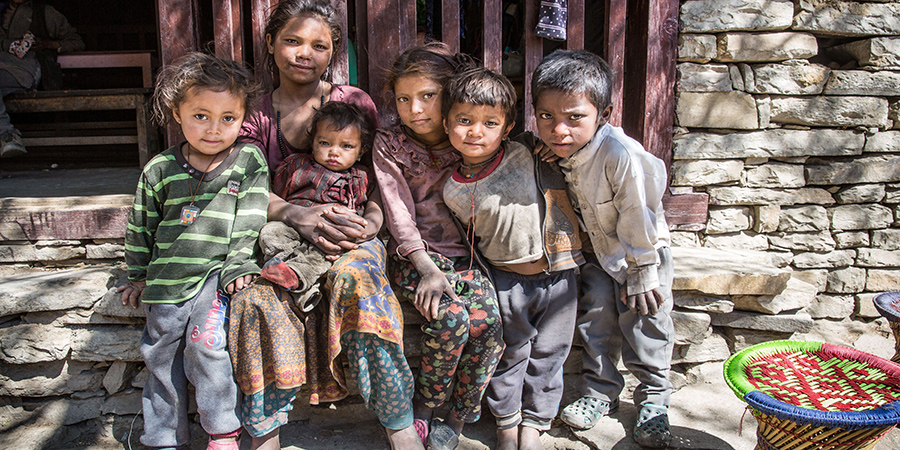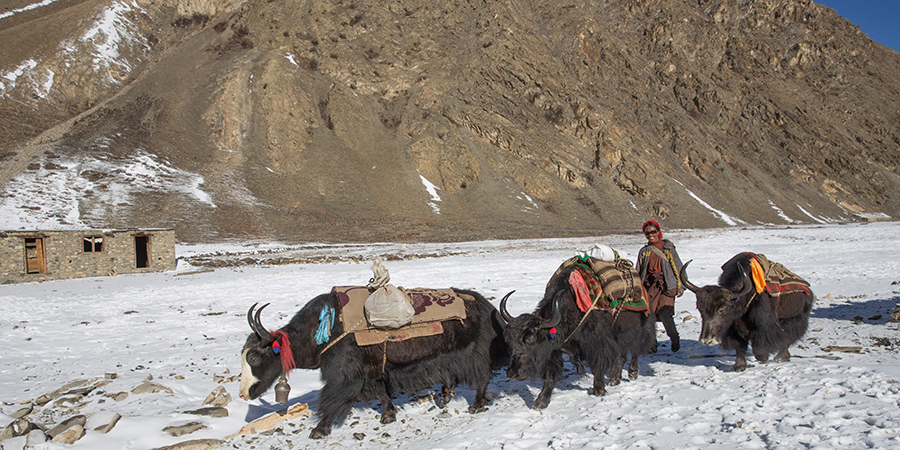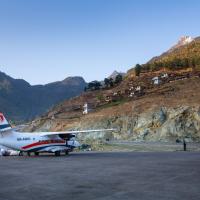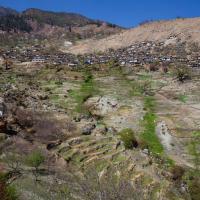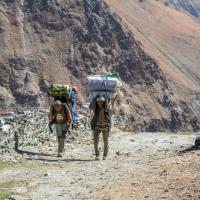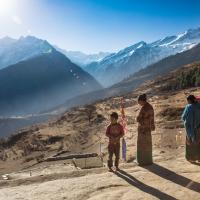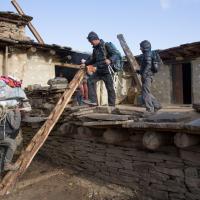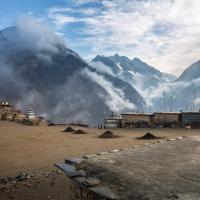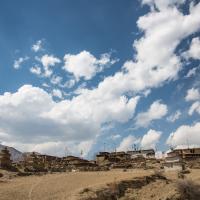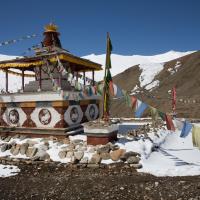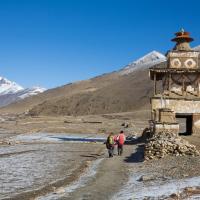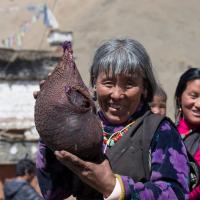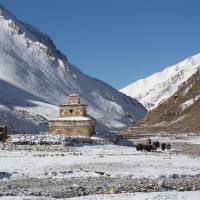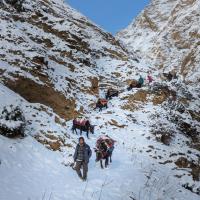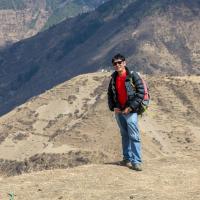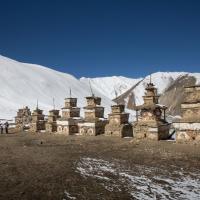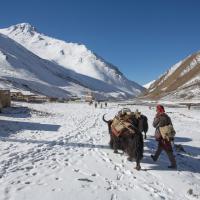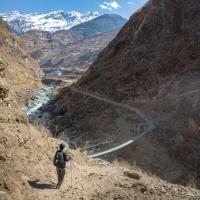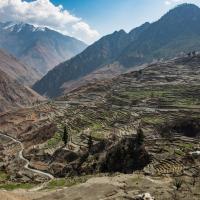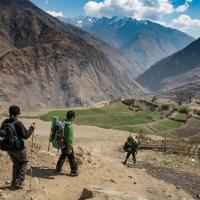

Email Us
contact@destinationhimalayatreks.com
Viber/Whats App 
+977-98510 16814 (Min Gurung)+977-98511 46814 (Tara Rana)
Lower Dolpo Trek 18 Days
$1899 per Pax
Overview
Lower Dolpo Trekking is another famous restricted area trek in Nepal. This trek comprises naturally beautiful and culturally important places and villages of the Lower Dolpo region. This trek is also adventurous because trekkers need to cross the challenging passes named Numa La (4,420m), and Baga La (4,080m) to complete this trek. During this trek, trekkers get the opportunity to visit ancient villages of the Lower Dolpo region such as Tarakot, Dho Tarap, and Ringmo where trekkers can know and experience the diverse culture, systems, customs, rituals, festivals, and way of life of different ethnic groups. Shey Phoksundo Lake is the final destination of the lower Dolpo trek. Shey Phoksundo Lake is very magnificent with its clear blue water.
Some of the areas of the lower Dolpo region are protected by the Shey Phoksundo National park. The trekking route of the lower Dolpo region goes through the beautiful and dense forests of Shey Phoksundo national park where trekkers can see the different species of flora and fauna. The forests of Shey Phoksundo national park mainly comprise blue pine, spruce, cypress, poplar, deodar, fir, and birch. In these dense forests, trekkers can see several rare and non-rare wild animals such as snow leopards, blue sheep, wolves, jackals, Himalayan black bears, Himalayan weasel, Himalayan mouse hare, langur, and rhesus monkeys.
Lower Dolpo is one of the most remote areas of Nepal so trekkers need to endure many difficulties during this trek. Trekkers should have sound health and good trekking experience to complete this trek. Despite the hardship during lower Dolpo treks, trekkers are rewarded by the natural and cultural beauties of the region which make this trek mesmerizing. Lower Dolpo is listed in restricted trekking areas of Nepal so a special trekking permit should be required before trekking this region. As a government-registered trekking agency, we arrange trek permits for the lower Dolpo trek.
- Beautiful landscapes of the Lower Dolpo region
- Mesmerizing Shey Phoksundo Lake
- Shey Phoksundo national park and its diverse flora and fauna
- Ancient villages such as Tarakot, Dho Tarap, and Ringmo
- Diverse culture, systems, customs, rituals, festivals, and ways of life of different ethnic groups
Short Itinerary
Day 01: Pick up from the airport and drop by the hotel
Day 02: Working day for required permits, you do shopping or look around the city, hotel
Day 03: Fly from Kathmandu to Nepalgunj
Day 04: Fly from Nepalgunj to Juphal, then trek to Dunai (2140 meters)
Day 05: Dunai to Tarakot, (2537m)
Day 06: Tarakot to Laina Odar, (3370m)
Day 07: Laina Odar to Ghyamgar (3756m)
Day 08: Ghyamgar to Dho Tarap, (3944m)
Day 09: Exploration day
Day 10: Dho tarap to Numala Base Camp (4420m)
Day 11: Numa La Base camp to Bagala Base Camp, (4115m)
Day 12: Bagala base Camp to yak kharka, (3982m)
Day 13: Yak kharka to Ringmogaun Phoksundo, (3733m)
Day 14: Ringmogaun to Chepka, (2838m)
Day 15: Chhepka to Sulighat, (2282m)
Day 16: Sulighat to Juphal (2475m)
Day 17: Juphal to Nepalgunj then fly to Kathmandu
Day 18: Transfer to the airport for your onward destination
Includes
- All land transportation as required for trip and airport pick up-drop.
- Hotel in Kathmandu for above mentioned program.
- Accommodation and foods during the trek.
- Domestic flight tickets.
- Dolpo entry permit and trekking permit and national park permit.
- Related language speaking guide,special camping cook and necessary crews.
- Allowances for all Nepali team and their insurance.
- Emergency evacuation service if in case...needed
Excludes
- Foods in Kathmandu
- Your personal trekking gears and expenses
- Emergency rescue cost if in case
- Tip to guide, porters
Detail Itinerary
-
Day 01: Pick up from the airport and transfer to the hotel
Our representative welcomes you outside the International Airport. After completing all the formalities, you are picked up from the airport and transferred to the hotel.
-
Day 02: Working day for required permits, you do shopping or look around the city, hotel
The pre-trip meeting is done after breakfast. All details and arrangements of the trip are explained and necessary permits are collected. After completing all procedures, proceed for short sightseeing around Kathmandu city. Visit Kathmandu Durbar Square and return to the hotel. Arrange a backpack with all the necessary things. Stay overnight at a hotel.
-
Day 03: Fly from Kathmandu to Nepalgunj
A scenic flight from Kathmandu to Nepalgunj. Enjoy the beautiful views of the mountains. Upon arriving, transfer to a hotel. Later, visit the nearby places in Nepalgunj, Spend overnight at a hotel.
-
Day 04: Fly from Nepalgunj to Juphal, then trek to Dunai (2140 meters)
A short flight from Nepalgunj towards Juphal. Upon arriving at Juphal, the trek commences to Dunai. Pass along the Thulo Bheri river adoring the natural beauty of the surroundings. Arrive at Dunai after 3 hours and set a camp. Rest for a while and if you wish, explore the nearby places. Stay overnight at a camp.
-
Day 05: Dunai to Tarakot, (2537m)
Walk through the pine forest and pass along the terraced fields. Witness the beautiful views on a clear day and arrive at Tarakot. Visit the Sandul Gompa and get a sight of several chortens and mani walls. Stay overnight at a camp.
-
Day 06: Tarakot to Laina Odar, (3370m)
Walk through several suspension bridges and pass the lush forest to reach Laina Odar. The Cliffside nearby is strange and a cave nearby is perfect to set the camp. Stay overnight at a camp.
-
Day 07: Laina Odar to Ghyamgar (3756m)
Walk through the barren landscapes leaving the dense forest. Slowly ascend through the side of Tarap Khola and get some sights of blue sheep and yaks. Cross the suspension bridge over the Chaya Khola to reach Nawarpani. Keep continuing until Ghyamgar. Stay overnight at a camp.
-
Day 08: Ghyamgar to Dho Tarap, (3944m)
Walk on the trail following the Tarap Khola and descend towards the narrow valley. Witness several stupas and chortens on the way and pass through it to reach Dho Tarap. This beautiful Tibetan village is the destination to set up the camp. Stay overnight at a camp.
-
Day 09: Exploration day
The rest day is scheduled for proper acclimatization to adjust to the higher altitudes. The day is the full exploration day and won’t miss this opportunity. A visit to the Gompas, interacting with locals and learning about their culture and lifestyle. The breathtaking views of mountain peaks and enjoy walking around the attractive laneways. Also, visit the nearby places and stay overnight at a camp.
-
Day 10: Dho tarap to Numa La Base Camp, (4420m)
An exciting trek towards Numala Base camp begins. Walk through the barren part of the valley on the northern side admiring the stunning landscapes. In the backdrop, the spectacular views of Mt. Dhaulagiri and other peaks are mesmerizing. Keep walking to the trail and reach the rocky basin. Finally, arrive at Numa La Base Camp and set a camp for an overnight stay.
-
Day 11: Numa La Base camp to Bagala Base Camp, (4080m)
Get ready to walk towards the Numa La Pass from the Numa La Base Camp. A challenging yet exciting experience to reach the top of the pass. Slow and careful walk towards the top and witness the fabulous scenery from there. After that, walk downhill along the terraced fields, and yak pastures and reach Danigar. Continue walking through a deep gorge adoring the mountain ranges and surrounding natural beauty. Feel the change in climate and pass through the pine forest towards the Bagala Base Camp. Stay overnight at a camp.
-
Day 12: Bagala base Camp to Yak Kharka, (3982m)
Walk on the steep trail and keep on ascending. From the top, enjoy the spectacular views of majestic peaks including Norbung Kang and attractive Phoksundo Lake. Slowly descend and arrive at Temche. From there, walk downhill a little further and reach Yak Kharka. Stay overnight at a camp.
-
Day 13: Yak Kharka to Ringmo gaun – Explore Phoksundo, (3733m)
An ascend walk towards beautiful Ringmo Gaun through the forest trail. A pleasant experience walking in the lush green forest full of pine, oak, juniper, and cypress trees. Also, in the background, the snow-capped mountains add more beauty. Arrive at Tibetan Bon settlement village Ringmo. Set up a tent camp and rest for a while. Then, head towards the mesmerizing and deepest Phosundo Lake of Nepal. A short walk from the Ringmo takes us to the vicinity of the lake. Shey Phoksundo Lake is very magnificent with its clear blue water. Spend some time and take some pictures and return to the village. Later, explore the Tshowa Monastery which was built 900 years ago. Interact with locals and get to learn about their culture, religion, customs, and way of living. Stay overnight at a camp.
-
Day 14: Ringmo gaun to Chhepka, (2838m)
A slow walk along the riverside and a steep ascent towards the hilltop. Get an awesome view of the mesmerizing Phoksundo Lake for one last time. After that, climb downhill and move forward to Chunuwar. Pass through the forest trail of pine and birch trees and reach Renje. Arrive at Chhepka after a few ascends and descends through the trail. Stay overnight at a camp.
-
Day 15: Chhepka to Sulighat, (2282m)
Walk across the villages of Shyanta and Kageni and through the forested trail. Arrive at the checkpoint of Shey Phoksundo National Park. Traverse through a suspension bridge over the Dhim Khola. From there, keep continuing until Sulighat. Stay overnight at a camp.
-
Day 16: Sulighat to Juphal (2475m)
An ascending walk towards Dunai commences traversing the Bheri River. Admire the beautiful scenery and pass several villages before reaching Juphal. Walk through the narrow path and pass the lovely fields of wheat and barley. Arrive at Juphal and stay overnight at a hotel.
-
Day 17: Juphal flies to Nepalgunj then fly to Kathmandu
A scenic flight from Juphal to Nepalgunj. After that, board for the Kathmandu flight as per the schedule. Rest in a hotel room or explore nearby places if time permits. Return to Kathmandu and then transferred to a hotel. Rest, relax, and spend a night in a hotel.
-
Day 18: Your program
After completing the long but fruitful trek, a leisure day for you to schedule your program and enjoy the time. Utilize the day, exploring or shopping, or enjoying cuisines. Spend the day as you desire and as your program and schedule.
-
Day 19: Transfer to the airport for your onward destination
Our representative bids farewell and transfers you to the airport for your onward destination. A final goodbye and looking forward to seeing you again in Nepal.
-
Travel Information Lower Dolpo
Accommodation and Duration
Accommodations in the Lower Dolpo Treks are mostly tented camps. The trek duration is of 19 days including arrival in Kathmandu to departure from the International Airport. But, from the starting point to the end point, the actual trek duration is 13 days. Lower Dolpo is a remote place and thus the accommodation for 11 days is in a tented camp. The remaining days are spent in a comfortable hotel with good facilities.
We provide you with high qualities equipment, the best quality tents for the kitchen, dining sleeping, & toilets, a gas stove for cooking meals & necessary cooking utensils, towels, hand wash soaps, toilet papers, and dining chairs & tables for eating. Don’t panic as all this equipment is carried by our porters. Besides this, carry your hygiene kit.Meals
Breakfast, Lunch, and Dinner are provided during the camping treks, and only breakfast during your stay in the hotels. A professional chef accompanies you during the camping treks and serves you healthy and hygienic local Nepali dishes. The staple dish is Nepali Dal Bhat with vegetable curry, pickles, and seasonal salads. The food ingredients are carried since the Lower Dolpo Trek is a fully camping trek. Thus, don’t expect a high variety of dishes but basic food dishes with limited varieties are served which are high in nutritional value and suitable for the trek. Some food items like dal, bhat, vegetable curry, eggs, soups, noodles, hot tea, coffee, roti (bread), jam, etc. are served.
Drinking water
Drinking water in the hotels is easily available of your choice. You can buy mineral water bottles too. During the camping treks, drinking water for you is boiled water. If you feel uncomfortable or have some doubts, fill the water in your bottle. And, apply purification treatment using water purification tablets or devices. Don’t forget to bring water purification tablets, and a sustainable water bottle. Having your water bottle helps in minimizing the wastage of plastic water bottles.
Communication
Dolpo is a remote region and only a few places have communication signals. Though some villages have satellite telephones, it is used for emergency purposes. With an additional charge, you can use the Wi-Fi facility in Dunai. Since the place is very remote, they are not equipped with all facilities. Bring necessary equipment like a solar power bank for charging your cameras and phones. The remoteness of Lower Dolpo is its beauty to keeps you away from the hustle and bustle of crowds. So, enjoy the trek and create some best memories without worries about using mobile phones or checking emails.
Starting and Ending points
The starting point of the Lower Dolpo Trek is from Juphal and ends in Juphal. From Juphal, take a flight to Nepalgunj and from Nepalgunj return to Kathmandu via plane.
Permits Required
Restricted Area Permits (RAP) for Lower Dolpo and Shey Phoksundo National Park Permits are required to trek to Lower Dolpo.
Lower Dolpo permit fee: USD 20 per person/week
Shey Phoksundo National Park Permit fee: NPR 3000Travel Insurance
Travel Insurance is compulsory while traveling. In the case of Lower Dolpo Trek, travel insurance is strongly recommended due to the remoteness of the region. It acts as a safety guard against possible emergencies. Any happenings during the trek are the clients’ sole responsibility. Therefore, have travel insurance that covers all medical emergencies, helicopter rescue, air ambulance, flight cancelations, loss/theft of luggage, personal expenses, cover repatriation, evacuations, and altitude sickness. Do carry a copy of your travel insurance and also send a copy to us for making the necessary arrangements in case of emergencies.
Safety and our guides
We assure you 100% when it comes to safety. Our client’s safety is our main concern. Our guides are certified and well-trained with years of expertise in this field. They are technically competent and have excelled in safety performance. They always carry essential safety equipment, gear, and first-aid kits. For the safety of our trekkers, the itinerary is properly scheduled and acclimatization rest days are properly set up to adjust to the high altitude and prevent altitude sickness. If any queries concerning safety, feel free to share them with our guides. We are always there for your services.
Best time to trek Lower Dolpo Trek
Mostly summer and autumn seasons are termed best for trekking in the mountains. But, Lower Dolpo is exceptional. Dolpo region of Nepal sees annual rainfall of less than 50mm. This makes Dolpo a perfect destination to trek from May to October. The monsoon season in Nepal is from June to August. Dolpo region of Nepal has the benefit of rain-shadow areas making it suitable for trekkers to trek in the monsoon season as well. During winter, the Dolpo region is closed for trekking as heavy snowfall occurs making it difficult for trekkers from November to April.
Lower Dolpo Trek Difficulty
Lower Dolpo Trek’s duration is 19 days. For almost 2 weeks, the trekking trail is in the remote region of Dolpo. Thus, it is one of the longest treks in the remote region of Nepal. The highest pass during the trek is Numa La Base Camp which is at an elevation of 4,420m. The trekking trail is very remote, barren, and has very little or no access to all sorts of facilities. Thus, trekkers must be physically fit and in good health condition before commencing the Lower Dolpo Trek. The trail consists of several ascends, descends, rough paths, and tough as the altitude rises. So, it is better to consult the doctor before starting the trek and perform all check-ups and take necessary actions. We suggest you take some physical exercises in different forms like swimming, cycling, running, day hiking, etc. for months before the Lower Dolpo Trek. Although the trek is tough, we assure you that the itinerary is planned with proper rest days which helps to complete the trek smoothly.
Acclimatization and Altitude Sickness at Lower Dolpo Trek
Acclimatization or rest days are quintessential during trekking. The Lower Dolpo Trek is one of the most difficult treks in Nepal due to its remoteness. Thus, acclimatization day is properly planned in the itinerary to prevent altitude sickness and adjust to higher altitudes. Dho Tarap (3,944m) is a rest day spot during the Lower Dolpo Trek. Most of the days are spent at an altitude of over 3000m. There is a great probability of altitude sickness.
Symptoms of Altitude Sickness
Primary: Headache, nausea, gasping, appetite & sleep loss, dizziness, fatigue, vomiting
Extreme: primary symptoms and hallucinations & unconsciousnessPreventive Guidelines
- Immediately inform the guide
- Warm-up, and body stretch before the trekking journey
- Drink water and Hydrate yourself at regular intervals
- Frequent urination throughout the journey
- Ascend slowly and gradually
- Take plenty of rest and sleep
- Avoid salty foods, alcohol, and smoking
- Descend immediately when it’s difficult/uneasy
- Take medicine consulting a guide
Luggage limitation for Porter
The luggage limitation depends on the trek duration and maximum altitude gain. Normally, one porter carries the luggage of two trekkers. The luggage limitation per person is a maximum of 15 kg. Since this is a camping trek, the camping pack is up to 40 kg. All arrangements are made considering the health of the porters.
- Shoes: Pair of hiking boots, Rubber sandals
- Clothes: Windcheater jacket, Thermals, Down Jacket, Fleece, Long sleeve shirts, Gloves, Towels, Inner garments, Trekking pants, Trousers, Shorts, Socks
- Accessories: Sunglasses, Hats/Caps, Sunscreen, Lip Balm, Water bottles, Pocket Knife, Water Purifying solution
- Equipment: Warm Sleeping bags, Map, Trekking poles, Duffel bag
- Medicine: First-Aid Kit, Altitude sickness medicines
- Rainy season: Waterproof clothes, boots, Raincoat, Anti-leech socks
- Winter Season: Woolen clothing items (light)
It is best to bring the clothes and essential equipment from your home from the provided checklist. Also, you can buy or rent equipment and clothes in Kathmandu.
